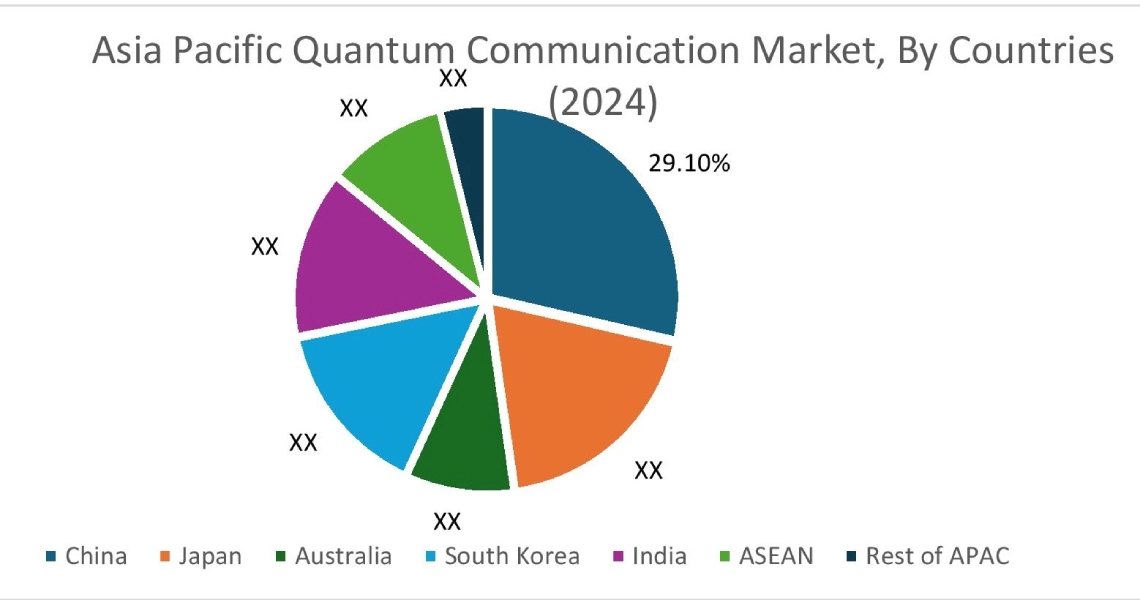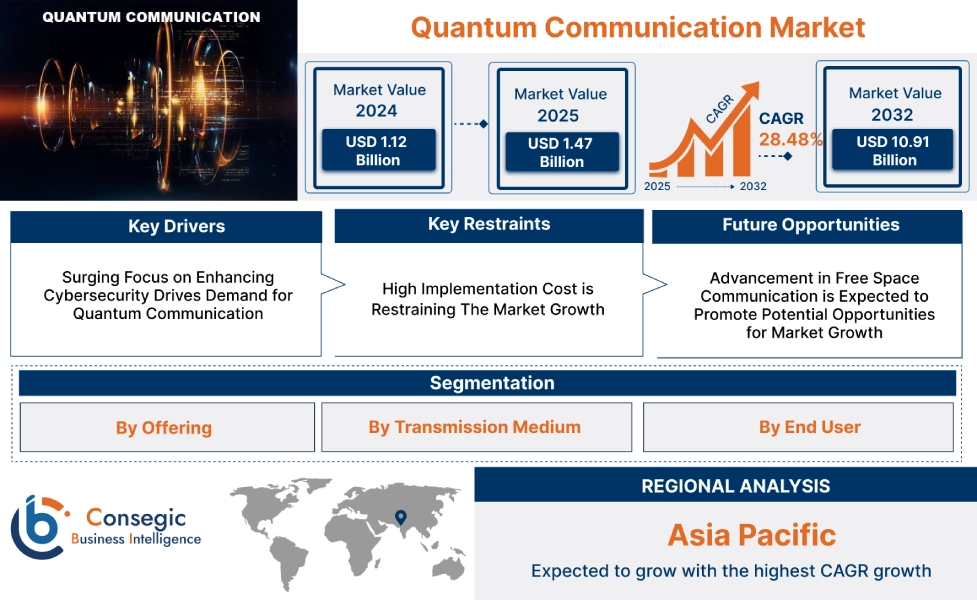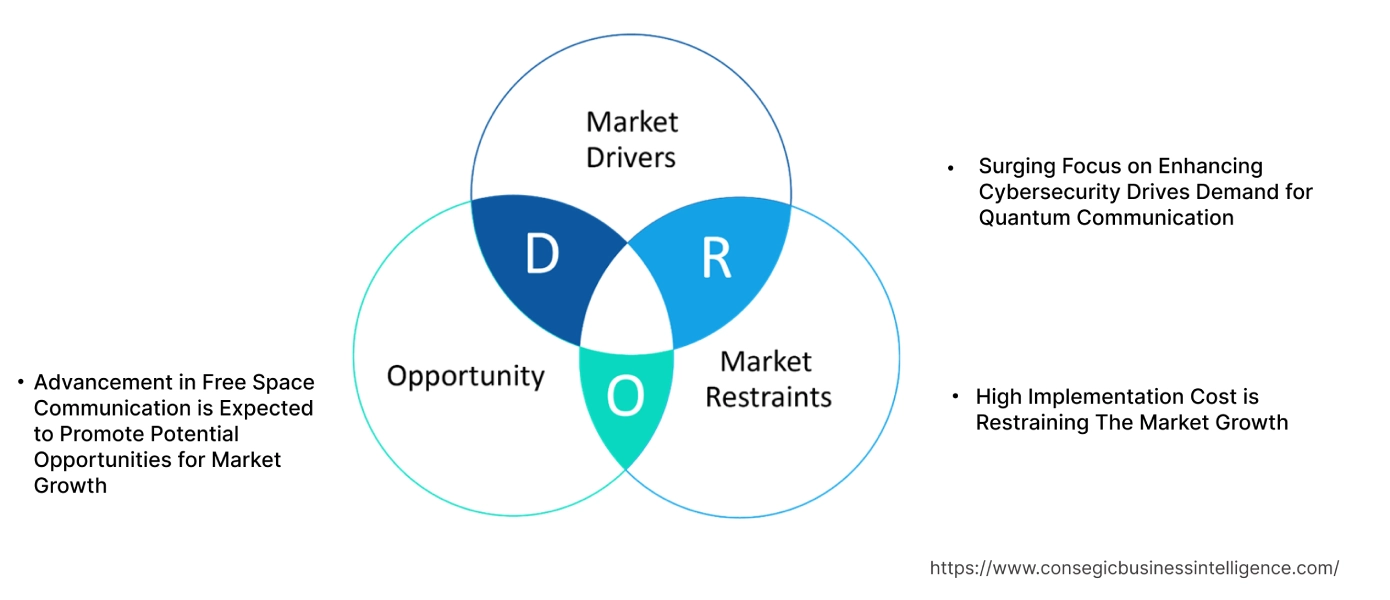Quantum Communication Market Size:
Quantum Communication Market size is estimated to reach over USD 10.91 Billion by 2032 from a value of USD 1.12 Billion in 2024 and is projected to grow by USD 1.47 Billion in 2025, growing at a CAGR of 28.48% from 2025 to 2032
Quantum Communication Market Scope & Overview:
Quantum communication refers to the transmission of quantum information between interconnected quantum nodes. Additionally, the key benefits include enhanced security, improved efficiency, and others are driving the quantum communication market growth. Moreover, the increasing need for secure communication is driving the quantum communication market demand. Further, the ability to protect sensitive financial data from cyberattacks is driving the quantum communication industry.
Key Drivers:
Surging Focus on Enhancing Cybersecurity Drives Demand for Quantum Communication
The advancement capabilities of quantum technology are making it ideal for protecting sensitive information in critical sectors such as BFSI and healthcare, which is fueling the quantum communication market demand. Additionally, the increasing focus on enhancing cybersecurity compliance is boosting the quantum communication market growth. Further, the rising focus on ensuring transaction integrity and confidentiality is driving the market progress.
- For instance, in June 2025, F5 launched a security platform designed for post-quantum cryptography solutions to secure applications and APIs while maintaining high performance and scalability.
Therefore, the increasing focus on enhancing cybersecurity is driving the adoption of quantum technology, in turn, proliferating the market progress.
Key Restraints:
High Implementation Cost is Restraining The Market Growth
The communication relies on specialized hardware such as single-photon detectors and sources among others, which incurs huge costs, thereby, restraining the quantum communication market expansion. Additionally, implementation requires significant infrastructural changes and upgrades, which add to the overall cost. Further, the operation requires specialized expertise, making it challenging for widespread adoption, particularly for smaller businesses.
Therefore, the high implementation cost is restraining the quantum communication market expansion.
Future Opportunities :
Advancement in Free Space Communication is Expected to Promote Potential Opportunities for Market Growth
The free space communication involves transmitting quantum information through the atmosphere, eliminating the need for physical fiber optic cables. Additionally, the free space communication offers advantages in terms of deployment flexibility and reduced reliance on fiber optic infrastructure, which is paving the way for quantum communication market opportunities. Further, technological advancements are paving the way for the creation of hybrid quantum networks as well as versatile quantum based communication infrastructure.
- For instance, according to PIB India, the DRDO & IIT Delhi collectively demonstrated secure communication using quantum entanglement for over a distance of 1 km in June 2025, which in turn is paving the way for market prospects.
Hence, the rising advancements in free space communication are anticipated to increase the utilization of quantum technologies, in turn driving the quantum communication market opportunities during the forecast period.
Quantum Communication Market Segmental Analysis :
By offering:
Based on offering, the market is segmented into solutions and services.
Trends in the offering:
- Increasing trend in adoption of quantum based communication solutions, due to its several benefits, including superior encryption, enhanced security, secure data transfer, and others.
- Rising adoption of quantum-secured communication solutions in government & defense, BFSI, telecommunication, and other industries is driving the market.
The solutions segment accounted for the largest revenue share in the total quantum communication market share in 2024, and it is anticipated to register substantial CAGR during the forecast period.
- The solutions segment primarily includes single-photon detector, quantum random number generator, single-photon frequency conversion, quantum key distribution (QKD), and others.
- Single-photon detectors enable the detection of individual photons, which are essential for secure data transmission in turn fueling the quantum communication market size.
- Meanwhile, quantum key distribution (QKD) offers secure communication by using quantum mechanics to generate and distribute cryptographic keys.
- Moreover, these solutions offer unbreakable encryption while preventing data breaches and unauthorized access, with applications across various sectors.
- For instance, in April 2025, Sterlite Technologies Ltd. (STL) and Centre for Development of Telematics (C-DOT) attained the first quantum key distribution (QKD) over multi-core fibre in India. This marks a key milestone in the country's shift towards quantum-secured communication networks.
- According to the analysis, the rising advancements associated with quantum-secured communication solutions are further propelling the market growth.
By Transmission Medium:
Based on transmission medium, the market is bifurcated into fiber-based QKD and free-space/satellite-based QKD.
Trends in the transmission medium:
- There is a rising trend towards the utilization of live fiber-based QKD for offering enhanced security for data transmission by leveraging the principles of quantum mechanics, which is further driving the quantum communication market trends.
- Increasing adoption of free-space/satellite-based QKD for long-distance communication, due to its ability to overcome the limitations of signal attenuation in optical fibers, is projected to drive the market growth.
Fiber-based QKD segment accounted for the largest revenue in the overall quantum communication market share in 2024.
- Fiber-based quantum key distribution (QKD) refers to a method of secure communication that leverages the principles of quantum mechanics to generate and distribute cryptographic keys.
- Moreover, this approach offers significant benefits as compared to conventional cryptography by providing enhanced security based on quantum mechanics, making it resistant to potential attacks and threats.
- For instance, in March 2025, Toshiba Digital Solutions Corporation and KDDI Research Inc. developed a multiplexing technology for quantum key distribution (QKD). This technology is capable of assigning secret keys to the C-band and high-volume data signals to the O-band, which enables multiplexed transmission over a single optical fiber.
- Consequently, as per the market analysis, the aforementioned factors are driving the quantum communication market trends.
The free-space/satellite-based QKD segment is anticipated to register the fastest CAGR during the forecast period.
- Free-space/satellite-based quantum key distribution (QKD) enables secure communication by leveraging quantum mechanics to generate and distribute encryption keys.
- Moreover, free-space/satellite-based QKD uses satellites for transmitting quantum signals between ground stations, potentially enabling long-distance, even intercontinental, secure communication.
- Additionally, this approach can overcome limitations of terrestrial fiber-based systems by minimizing signal loss in free space in turn fueling the quantum communication market size.
- Further, free-space/satellite-based QKD is particularly useful for long-distance communication, due to its ability to overcome the limitations of signal attenuation in optical fibers.
- For instance, in March 2024, C-DOT and Physical Research Laboratory (PRL) demonstrated an integration of indigenous fiber-based QKD system with free-space QKD system, in turn leading to end quantum based communication link in both fiber as well as free space as transmission medium.
- Thus, according to the quantum communication market analysis, the rising advancements related to free-space/satellite-based QKD are anticipated to boost the market during the forecast period.
By End User:
Based on end user, the market is segmented into BFSI, aerospace, government & defense, IT & telecom, healthcare, energy & utilities, and others.
Trends in the end user:
- Rising adoption of quantum-based communication solutions in the government & defense sector for securing transmission of highly sensitive data, including military secrets, diplomatic communications, and intelligence information, is driving the market.
- There is an increasing trend in adoption of quantum-based communication solutions in the BFSI industry to address the growing need for enhanced security in financial transactions and customer data protection against advanced cyber threats.
Government & defense segment accounted for the largest revenue share of 23.50% in the overall market in 2024.
- Quantum communication is primarily used in the government & defense sector for providing highly secure communication channels by utilizing the principles of quantum mechanics.
- This technology provides unbreakable encryption, which makes it ideal for protecting sensitive information and national security.
- Moreover, quantum based communication ensures secure transmission of highly sensitive data, including military secrets, diplomatic communications, and intelligence information, among others.
- Additionally, quantum based communication can also be used for secure communication between military bases, within battlefields, and for transmitting classified information among deployed forces.
- For instance, according to the European Defense Agency, the general budget for the European Defence Agency was valued at USD 54,095.5 million in 2024, witnessing an increase of 11.1% in comparison to USD 48,704.4 million in 2023.
- Thus, according to the quantum communication market analysis, the growing government & defense sector is driving the adoption of quantum communication solutions for providing highly secure communication channels, thereby driving the market.
The BFSI segment is anticipated to register the fastest CAGR during the forecast period.
- Quantum communication is being increasingly utilized in the BFSI (banking, financial, and insurance) sector, due to its potential to provide unbreakable encryption and secure data transmission.
- This technology addresses the growing demand for enhanced security in financial transactions and customer data protection against advanced cyber threats.
- Moreover, it ensures secure key exchange for encrypting sensitive data such as transaction details and customer information, making it highly resistant to hacking attempts.
- For instance, according to the Federal Reserve Board, there are approximately 2,160 large commercial banks in the United States as of March 2025. These banks have consolidated assets of USD 300 million or more, with several branches in the U.S as well as other countries.
- Therefore, as per the market analysis, the growing BFSI sector and rising need for enhanced security in financial transactions are anticipated to boost the market during the forecast period.

Regional Analysis:
The regions covered are North America, Europe, Asia Pacific, Middle East and Africa, and Latin America.

Asia Pacific region was valued at USD 0.30 Billion in 2024. Moreover, it is projected to grow by USD 0.39 Billion in 2025 and reach over USD 3.01 Billion by 2032. Out of this, China accounted for the maximum revenue share of 29.10%. The market progress is mainly driven by rising government initiatives for research and development associated with quantum-based communication. Furthermore, factors including increasing demand for secure communication solutions and growing need for robust cybersecurity are projected to drive the market growth in the Asia Pacific region during the forecast period.
- For instance, in May 2025, Toshiba Asia Pacific Pte. Ltd. launched a quantum-safe network platform in collaboration with SpeQtral and Ciena to provide high-speed connectivity solutions.

North America is estimated to reach over USD 3.37 Billion by 2032 from a value of USD 0.34 Billion in 2024 and is projected to grow by USD 0.45 Billion in 2025. The North American region is heavily investing in quantum research and development, in turn offering lucrative growth prospects for the market. Additionally, the government and private sector partnership and investments are driving the market progress.
- For instance, in March 2025, IonQ deployed a quantum networking system for U.S. Air Force Research Laboratory. The advanced system is designed to enhance the precision, flexibility, and scalability of advancement of quantum networking and algorithms.
The regional analysis depicts that the increasing cybersecurity threats and the need for a secure communication infrastructure are driving the market in Europe. Additionally, the key factor driving the market in Middle East and African region is the rising digitalization and increasing cyber threats across several industries. Further, the rapid digital transformation and infrastructure development are paving the way for the progress of the market in Latin America.
Top Key Players and Market Share Insights:
The global quantum communication market is highly competitive with major players providing solutions to the national and international markets. Key players are adopting several strategies in research and development (R&D), product innovation, and end user launches to hold a strong position in the quantum communication industry. Key players in the quantum communication market include-
- Quantum Opus (USA)
- MagiQ Technologies (USA)
- Nu Quantum (UK)
- Mitsubishi (Japan)
- NTT Laboratories (Japan)
Recent Industry Developments :
Product launches
- In January 2025, Honda Research Institute USA, Inc. developed a novel method called nanoribbons, designed for secure communication of sensitive information.
- In September 2024, Boeing launched Q4S, designed for demonstrating quantum entanglement with swapping capabilities in orbit. The satellite has the capacity to process large amounts of data, which in turn provides potential to revolutionize industries.
Quantum Communication Market Report Insights :
| Report Attributes | Report Details |
| Study Timeline | 2019-2032 |
| Market Size in 2032 | USD 10.91 Billion |
| CAGR (2025-2032) | 28.48% |
| By Offering |
|
| By Transmission Medium |
|
| By End User |
|
| By Region |
|
| Key Players |
|
| North America | U.S. Canada Mexico |
| Europe | U.K. Germany France Spain Italy Russia Benelux Rest of Europe |
| APAC | China South Korea Japan India Australia ASEAN Rest of Asia-Pacific |
| Middle East and Africa | GCC Turkey South Africa Rest of MEA |
| LATAM | Brazil Argentina Chile Rest of LATAM |
| Report Coverage |
|
Key Questions Answered in the Report
How big is the quantum communication market? +
The quantum communication market size is estimated to reach over USD 10.91 Billion by 2032 from a value of USD 1.12 Billion in 2024 and is projected to grow by USD 1.47 Billion in 2025, growing at a CAGR of 28.48% from 2025 to 2032.
Which segmentation details are covered in the quantum communication report? +
The quantum communication report includes specific segmentation details for offering, transmission medium, end user, and regions.
Which segmentation details are covered in the quantum communication report? +
The quantum communication report includes specific segmentation details for offering, transmission medium, end user, and regions.
Which is the fastest segment anticipated to impact the market growth? +
In the quantum communication market, the BFSI is the fastest-growing segment during the forecast period due to growing BFSI sector and rising need for enhanced security in financial transactions.
Who are the major players in the quantum communication market? +
The key participants in the quantum communication market are Toshiba (Japan), Thales (France), Quantum Opus (USA), MagiQ Technologies (USA), Nu Quantum (UK), Mitsubishi (Japan), NTT Laboratories (Japan), Fujitsu (Japan), Crypta Labs (UK), HEQA Security (Israel) and others.
What are the key trends in the quantum communication market? +
The quantum communication market is being shaped by several key trends including rising utilization of live fiber-based QKD for offering enhanced security for data transmission by leveraging the principles of quantum mechanics and other.


